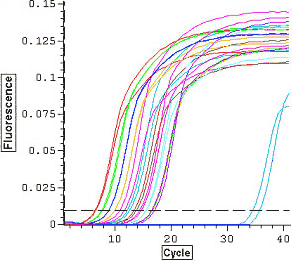|
Techniques home

Real-Time PCR Techniques
 Fluorescence-based
real-time reverse transcription PCR is a widely used method for the quantification
of mRNA levels in order to characterize or confirm gene expression patterns,
or to compare mRNA levels of different sample populations (Bustin S.A.,
2002). Real-time PCR allows for the
direct detection of PCR products, combining amplification and detection
in a single step. The sensitivity of this method permits the reliable
detection of small amounts of initial template, while delivering a linear
range of up to ten orders of magnitude in copy number. A typical amplification
plot of fluorescent intensities over 40 cycles is shown here. Fluorescence-based
real-time reverse transcription PCR is a widely used method for the quantification
of mRNA levels in order to characterize or confirm gene expression patterns,
or to compare mRNA levels of different sample populations (Bustin S.A.,
2002). Real-time PCR allows for the
direct detection of PCR products, combining amplification and detection
in a single step. The sensitivity of this method permits the reliable
detection of small amounts of initial template, while delivering a linear
range of up to ten orders of magnitude in copy number. A typical amplification
plot of fluorescent intensities over 40 cycles is shown here.
The Bauer Core provides access to two real
time PCR instruments that support all of the popular real-time chemistries.
Our staff helps users with experimental design and provides training
on the instruments.
For more information about real time PCR at the Bauer Core, please
contact Christian Daly (cdaly@cgr.harvard.edu).
Reference:
Bustin SA. Quantification of mRNA using real-time reverse transcription
PCR (RT-PCR): trends and problems. Journal of Molecular
Endocrinology (2002) 29: 23–39
|

 Fluorescence-based
real-time reverse transcription PCR is a widely used method for the quantification
of mRNA levels in order to characterize or confirm gene expression patterns,
or to compare mRNA levels of different sample populations (Bustin S.A.,
2002). Real-time PCR allows for the
direct detection of PCR products, combining amplification and detection
in a single step. The sensitivity of this method permits the reliable
detection of small amounts of initial template, while delivering a linear
range of up to ten orders of magnitude in copy number. A typical amplification
plot of fluorescent intensities over 40 cycles is shown here.
Fluorescence-based
real-time reverse transcription PCR is a widely used method for the quantification
of mRNA levels in order to characterize or confirm gene expression patterns,
or to compare mRNA levels of different sample populations (Bustin S.A.,
2002). Real-time PCR allows for the
direct detection of PCR products, combining amplification and detection
in a single step. The sensitivity of this method permits the reliable
detection of small amounts of initial template, while delivering a linear
range of up to ten orders of magnitude in copy number. A typical amplification
plot of fluorescent intensities over 40 cycles is shown here.